November 6, 2012
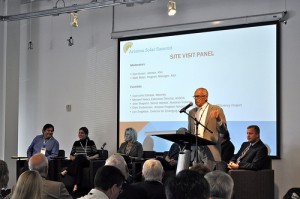 The Arizona Solar Summit III took place October 9-10, 2012 at ASU SkySong hosted in partnership with ASU LightWorks. The summit’s participants included a collective group of distinguished panelists all focused on highlighting game-changing efforts regarding Arizona’s position of leadership in the dynamically growing solar industry.
The Arizona Solar Summit III took place October 9-10, 2012 at ASU SkySong hosted in partnership with ASU LightWorks. The summit’s participants included a collective group of distinguished panelists all focused on highlighting game-changing efforts regarding Arizona’s position of leadership in the dynamically growing solar industry.
Day 1: Game-Changer Site Visits
The key theme of the summit circulated around game-changing efforts that encourage the growth of solar availability in Arizona. On Day 1 of the Solar Summit III, participants and industry leaders had the opportunity to visit sites across Arizona that have been continuing to implement solar energy into their communities. Visitors were able to explore firsthand the ground breaking ideas taking place. Game-changer site visits included the downtown Phoenix/Vistancia area, ASU Tempe campus, Gila Bend, the community of Eastmark in Mesa, and a pre-summit visit to a variety of solar sites in Tucson. The Game-Changer Site Visits aimed to provide visitors with an insider look at solar opportunities each site envisions for their area.
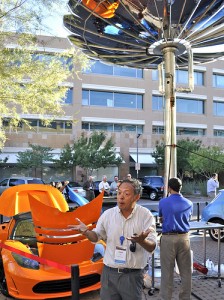 The visitors were then gathered together at the end of the day for a reception and dinner under the SkySong shade structure. Visitors were able relax and discuss important ideas with members from the solar industry, as well as to take part in the featured sustainable car show. The sustainable car show’s most impressive highlight was the solar powered Tesla roadsters. These extravagant hybrid cars, powered by either solar or natural gas, were being charged by Joseph Hui’s Monarch Lotus. The Monarch Lotus is an innovative solar charging structure that uses a new form of solar panels, made up of polycarbonate blades formed around an aluminum spine instead of the conventional photovoltaic panels that you see on rooftops of homes and buildings. Hui has great plans in taking the Monarch Lotus solar structure to fulfill primarily philanthropic efforts. The goal is to ensure people meet their basic needs of clean energy, water, transportation, and habitat, to progress toward a cleaner and greener planet.
The visitors were then gathered together at the end of the day for a reception and dinner under the SkySong shade structure. Visitors were able relax and discuss important ideas with members from the solar industry, as well as to take part in the featured sustainable car show. The sustainable car show’s most impressive highlight was the solar powered Tesla roadsters. These extravagant hybrid cars, powered by either solar or natural gas, were being charged by Joseph Hui’s Monarch Lotus. The Monarch Lotus is an innovative solar charging structure that uses a new form of solar panels, made up of polycarbonate blades formed around an aluminum spine instead of the conventional photovoltaic panels that you see on rooftops of homes and buildings. Hui has great plans in taking the Monarch Lotus solar structure to fulfill primarily philanthropic efforts. The goal is to ensure people meet their basic needs of clean energy, water, transportation, and habitat, to progress toward a cleaner and greener planet.
Day 2: Panel Discussions
The second day of the Solar Summit III focused on panelist discussion. Panels of the summit included discussion of current game-changing projects in Arizona cities, the progress made from the previous Solar Summit, and the vision to further develop solar initiatives taken from the views of an array of acclaimed panelist members and moderators.
Site Visit Panel
The Site Visit Panel consisted of representatives from the previous day site visits. These panelists led a discussion on what they were most impressed with at each site and specifically highlighted what they learned and saw.
Moderator Matt Miller started off the panel by asking: What did you see and what were your expectations from the tour?
Attorney Giancarlo Estrada took part in the Gila Bend visit and said, “Expectations were fully met.” Gila Bend has implemented new solar technologies such as thin film and solar thermal as well as large-scale utility projects including the Cotton Center, Paloma solar projects, Solana, and a new 32 MW development. Estrada said that learning how solar implementation has affected Gila Bend was what he most took away from the site visit.
Ellen Zuckerman, Arizona Program Associate of the Southwest Energy Efficiency Project, took the Eastmark visit tour, a mixed-use community in Mesa close to the Phoenix-Mesa Gateway Airport. “At first I was a little skeptical, but I was overall pleasantly surprised by their good thinking,” Zuckerman said of her expectations of the visit. The homes in the Eastmark community have been planned to be easily oriented into the grid, which would make solar integration easy in this community. Zuckerman also remarked on the availability of open space, use of shade to make walking more desirable, and the recycling initiatives within the community.
The next question was What are your recommendations for continuing sustainable solar integration into cities?
“We need to take advantage of our universities’ expertise,” said Lori Singleton, Director for Emerging Customer Programs at SRP. Singleton visited the ASU Tempe campus site visit and was very impressed with what she had learned from the visit. ASU Tempe campus site visit showcased the variety of solar projects taking place at the university. Projects included the PowerParasol installation, Decision Theater, The Sustainability Solutions Initiative, and the National Science Foundation-funded solar engineering research center and graduate degree program. “Utilities should look to universities to utilize their expertise in energy to help create a roadmap,” Singleton said.
John Shepard, senior advisor of the Sonoran Institute, said, “There’s an ample role for local governments to get involved.” Shepard visited the Tucson site, which showcased the University of Arizona’s Tech Park Solar Zone, Davies-Monthan Air Force Base, Armory Park del Sol, City of Tucson solar sites, and Pima Country Roger Wastewater and Solar facility. Shepard remarked that the impression he received from Tucson is that Southwest Arizona is a “laboratory for solar.” Shepard said that in order to sustain that position, it is important to incorporate local solar policy into our cities.
Michael Neary, Executive Director of AriSEIA, believes that the incorporation of policies will be the determining factor in continuing statewide solar integration into Arizona’s cities. Neary took part in the Phoenix/Vistancia site visit, which highlighted the integration of solar in commercial and residential rooftop settings. The site tour visited Arizona’s first net zero office building, the APS Chase Field installation, and SheaXero energy efficiency homes. “We need to understand the value of solar to the grid and to the long run,” Neary said. “Arizona will be solar leaders by developing strong solar policies.”
Mayoral Panel
The Mayoral Panel focused on current game-changing efforts that each mayor has implemented in their cities, as well as what new opportunities they see for solar and what they mean in terms of economic development. Each mayor also discussed what they envision for their city, in terms of sustainability and solar initiatives, and what the challenges are in doing so. The mayors of this panel included Mayor Georgia Lord of City of Goodyear, Mayor Scott Smith of City of Mesa, Mayor Greg Stanton of City of Phoenix, and Mayor Doug Von Gausig of Town of Clarkdale.
Working Group Panel
The Working Group Panel consisted of leaders from four working groups, with Gary Dirks standing in for Ardeth Barnhart: Supply Chain, Applied Research Collaborations and Pilot Projects, Policy and Finance, and Building the Narrative. Each panelist was led by moderator Gary Dirks of ASU LightWorks who focused questions on reviewing the previous solar summits and discussing current progress and findings within each working group.
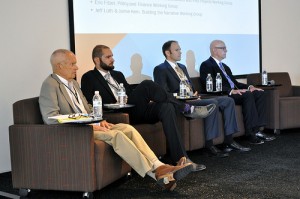 Building the Narrative, headed by Jeff Luth and assisted by solar graduate Jamie Kern. Luth noted a general lack of participation from the community in the solar discussion. “Solar advocates are generally preaching to the choir,” he said. There need to be vastly more people involved. Luth suggested the creation of an umbrella organization for collaboration in these talks to broaden the understanding that solar is technologically and commercially viable. “Arizona should be more informed about how solar fits into the energy mix,” he said. “We have to get together.” Kern recommended developing a coherent, easily understood solar narrative. He highlighted education and called for the unification of voices saying, “Solar is neutral, non-partisan, and a contributing factor to the future of Arizona’s economy.” While he highlighted education initiatives at ASU, he also noted that the greatest challenge is educating policymakers on solar policy tools. Renewable energy, and solar in particular, are not new discussions. Kern showed a clip from Bell Lab’s 1956 film “Our Mr. Sun” (available at the end of this section). Kern talked briefly about the Solar Decathlon as a way to show Arizona solar expertise and market Arizona as a brand.
Building the Narrative, headed by Jeff Luth and assisted by solar graduate Jamie Kern. Luth noted a general lack of participation from the community in the solar discussion. “Solar advocates are generally preaching to the choir,” he said. There need to be vastly more people involved. Luth suggested the creation of an umbrella organization for collaboration in these talks to broaden the understanding that solar is technologically and commercially viable. “Arizona should be more informed about how solar fits into the energy mix,” he said. “We have to get together.” Kern recommended developing a coherent, easily understood solar narrative. He highlighted education and called for the unification of voices saying, “Solar is neutral, non-partisan, and a contributing factor to the future of Arizona’s economy.” While he highlighted education initiatives at ASU, he also noted that the greatest challenge is educating policymakers on solar policy tools. Renewable energy, and solar in particular, are not new discussions. Kern showed a clip from Bell Lab’s 1956 film “Our Mr. Sun” (available at the end of this section). Kern talked briefly about the Solar Decathlon as a way to show Arizona solar expertise and market Arizona as a brand.
Applied Research Collaborations and Pilot Projects, headed by Ardeth Barnhart (presented by Gary Dirks). Dirks highlighted the UA SolarZone as an impressive collaborative project between academia and industry. “It showcases how multi-sector collaboration can bring projects to fruition,” he said. It exemplifies how R&D is a driver. Dirks took the opportunity to talk about how and why R&D is so crucial to technological innovation. “Continuity in R&D is critical,” he said. “The commercialization of test labs gives us important insight on what to expect from various technologies.” Along with the UA SolarZone, he also highlighted the ASU Solar Testing Lab as another successfully collaborative space. “I cannot stress how important commercialization test centers are.”
Supply Chain, headed by Bud Annan. “How do we even define the solar supply chain?” He asked. “We need to determine that first.” Annan expressed the need to consistently organize and publish data. We need to get a handle on how far the supply chain reaches, and we need long-term measurement standards. He suggested the state supply $250,000 for a three year study to learn about and determine the supply chain strengths and gaps in Arizona. The findings would be published as neutral, public data. “Arizona is capable of doing this,” he said.
Policy and Finance, headed by Eric Fitzer. “How do we, in Arizona, differentiate our energy mix?” asked Fitzer. Arizona has to determine how to make that transition and market itself. A photon-based economy must export solar, which requires new transmission to different markets. “Team up natural gas and renewables to achieve utility scale clean generation and export capabilities,” he said. “When you look at natural gas and renewable energy together, that’s the future of utility scale.” Fitzer recognized Gila Bend as a perfect pilot project for this scenario because its location is prime for a testing area for this kind of energy transmission. Arizona should find out what the California utilities need. Again, this group highlighted the need for collaboration.
Women Changing the Solar Game Panel
Representing the final panel discussion for the day, the Women Changing the Solar Game panel discussion hosted a choice assembly of distinguished women panelists who have each assisted in implementing solar initiatives in Arizona: Sandra Kennedy, Commissioner; Leisa Brug, Energy Policy Adviser to Governor Jan Brewer; Barbara Lockwood, General Manager of Energy Innovation at Arizona Public Service; Joy Seitz, Vice President of Business and Policy Development, American Solar; and Maja Wessels, Executive Vice President, Global Public Affairs, First Solar. The panel began with Bud Annan at the podium, showering the women with accolades as they each received an award for their roles in advancing solar in Arizona. The panel was then led by moderator Kris Mayes, Faculty Director of the Program on Law and Sustainability at ASU College of Law. Mayes led the panelists through discussions of what opportunities they see for solar in the future, the challenges and possible solutions for current initiatives, and the economic influence the solar industry has in Arizona.
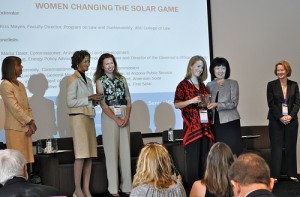 Leisa Brug made sure to note that in Arizona we have a governor who is very supportive of solar and clean energy. Brug, who is on the Governor’s Solar Task Force, mentioned that her group is currently working on a master energy plan for the state. She highlighted the Governor’s Renewable Tax Incentive as having drawn in many solar opportunities to Arizona.
Leisa Brug made sure to note that in Arizona we have a governor who is very supportive of solar and clean energy. Brug, who is on the Governor’s Solar Task Force, mentioned that her group is currently working on a master energy plan for the state. She highlighted the Governor’s Renewable Tax Incentive as having drawn in many solar opportunities to Arizona.
Commissioner Kennedy, who is currently up for re-election to the Arizona Corporate Commission, stated her strong support for Arizona solar and renewable energy. “I would like to change some of my colleagues’ minds about solar being too costly because we know that’s not true,” she said.
First Solar’s Maja Wessels said that we need to figure out how to integrate solar power as one of our traditional sources and talk about it as a traditional source because it is here to stay. “In the not too distant future we won’t need subsidies, but we still need policy,” she said. She argued that we need to raise our Renewable Energy Standard (RES) since we are already nearing the current 15% standard.
APS’ Baraba Lockwood said that the next phase of utility needs to incorporate solar safely and securely into the portfolio. She also recounted a story from the MIT clean energy forum she attended. A woman from South Africa wanted to incorporate solar because it is shown to cause a 70% reduction in the number of women who die in childbirth. “We’re lucky to be having the solar conversation,” she said. “Solar is in demand all over the world.”
Mayes made a point to note that the Arizona RES runs out in 2015, but we may not reach grid parity until 2020. “We need gap fillers,” she said.
Lockwood and Wessels both agreed that utilities should be able to rate base solar. Georgia Power is already doing this in a state with no Renewable Portfolio Standard (RPS).
Commissioner Kennedy and Joy Seitz both emphasized the need for education and civic engagement. Support solar? “Vote.”
Conclusion
Gary Dirks and Todd Hardy made closing remarks. Hardy mentioned that there will be new working groups to arise out of the summit discussions, which will appear on the AZ Solar Summit Website as they are formed.
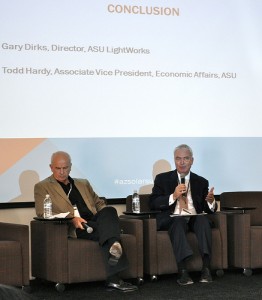 Dirks made a point to mention that 50% of Arizona’s current energy mix comes from transportation fuels. He highlighted the new ATP3 partnership as both a necessary collaboration between industry and academia as well as a way of branding Arizona as the go-to test-bed. He emphasized the importance of reducing our carbon footprint, analyzing and determining the environmental and climate effects of our energy choices, and supporting R&D as a way to accomplish those needs.
Dirks made a point to mention that 50% of Arizona’s current energy mix comes from transportation fuels. He highlighted the new ATP3 partnership as both a necessary collaboration between industry and academia as well as a way of branding Arizona as the go-to test-bed. He emphasized the importance of reducing our carbon footprint, analyzing and determining the environmental and climate effects of our energy choices, and supporting R&D as a way to accomplish those needs.
The underlying themes that have continued to arise in these summits on both solar and sustainability is the need for an educated community who engage in civic activities and educated leadership who can make informed decisions for Arizona. There is a pressing need for continued and expanded collaboration between various groups: government, university, industry, and the community.
Written by Gabrielle Olson and Sydney Lines, ASU LightWorks
Photos by Sydney Lines
Slideshow of Solar Summit III Flickr photos taken by Sydney Lines, ASU LightWorks
Additional Information:
https://asunews.asu.edu/20121012_solarsummit

